
Chips that changed the classroom
It is the “sheer quality of the innovation” that set the Raspberry Pi apart from other candidates for this year’s MacRobert Award, says Dr Dame Sue Ion FREng FRS, Chair of the MacRobert Award judging panel. “By blending old and new technology with innovative systems engineering and circuit board design, the team has created a computer that is cheap, robust, small and versatile,” she added. Something that set out to reverse the decline in computing education in the UK not only achieved that goal but also had an impact far beyond the expectations of the small Cambridge team who came up with the idea for an inexpensive single-board computer for schools and hobbyists. The team’s work has also resulted in an intelligent, programmable controller that has found applications in many different industries.
Planting the seeds
Dr Eben Upton CBE set the ball rolling in 2006 while working as a Director of Studies at the University of Cambridge. He had noticed a decline in the programming abilities of students applying to study computer science at the university. At the same time, another Cambridge computer graduate, Dr David Braben OBE FREng, founder of Frontier Developments, had similar concerns about applicants for jobs at his computer gaming business. There was a growing view that this skills gap was due to the limited scope of computing teaching in schools. Students learned how to use word processors and spreadsheets, but had no opportunity to experience the thrill of writing software to do something creative with a computer.
Students learned how to use word processors and spreadsheets, but had no opportunity to experience the thrill of writing software to do something creative with a computer
Earlier generations of students had been able to experiment by programming devices such as the BBC Micro. Dr Braben certainly remembers that as being his introduction to computing, but these ‘hobbyist computers’ fell out of favour as schools moved over to the personal computers preferred by business users. With the memory of the BBC Micro as his inspiration, Dr Upton and his colleagues turned to his idea of an inexpensive single-board computer.
The advocates of the then unnamed initiative knew that they needed an organisation to develop the computer, to make it and to handle the allimportant communications with their target audience, schools and teachers. Professor Jon Crowcroft FREng, one of the initiators of the new computer and a leading academic in the computer laboratory at the University of Cambridge, suggested the name Raspberry, in line with the tradition of naming computers after a fruit.
Six engineering enthusiasts set up the Raspberry Pi Foundation – the name Pi comes from the Python programming language, one of many that the device can work with – as a charitable company. The original trustees brought academics and business people on board, including Dr Braben, Pete Lomas, Co-founder and Director of Systems Engineering for Norcott Technologies, an electronic design consultancy, and Jack Lang, a Cambridge technology entrepreneur.
I don’t think we could have done Raspberry Pi anywhere other than Cambridge
The trustees set out with goals to “get Raspberry Pis to kids” and provide secondary school pupils across the UK with access to the computers and the opportunity to learn to code. They also wanted to increase the public profile of learning to code so that the challenges and opportunities it presented became part of a national debate.
To achieve these ambitions, the team had to design a computer that would be inexpensive to make and sell. Fortunately, they could draw on plenty of local contacts. “I don’t think we could have done Raspberry Pi anywhere other than Cambridge,” Dr Upton said in a recent interview with the Centre for Computing History. There were plenty of academics and business people in the city who understood computing, and who also knew about how to finance and launch a new business.
Computer on a chip
By the time work started on what was to become the Raspberry Pi, Dr Upton had joined the Cambridge office of US company Broadcom as a chip architect. A small team of enthusiasts at Broadcom set to work, often in their spare time, to do “much of the practical heavy lifting,” as he puts it.
Broadcom designs chipsets for mobile phones. Dr Upton and his colleagues realised that there was enough room for a conventional central processing unit (CPU) on the latest multimedia chip, and that by doing so they could turn it into the basis for a general-purpose computer. Rather than invent his own processor, Dr Upton chose a CPU from ARM, another Cambridge company designing silicon IP for mobile telephones.
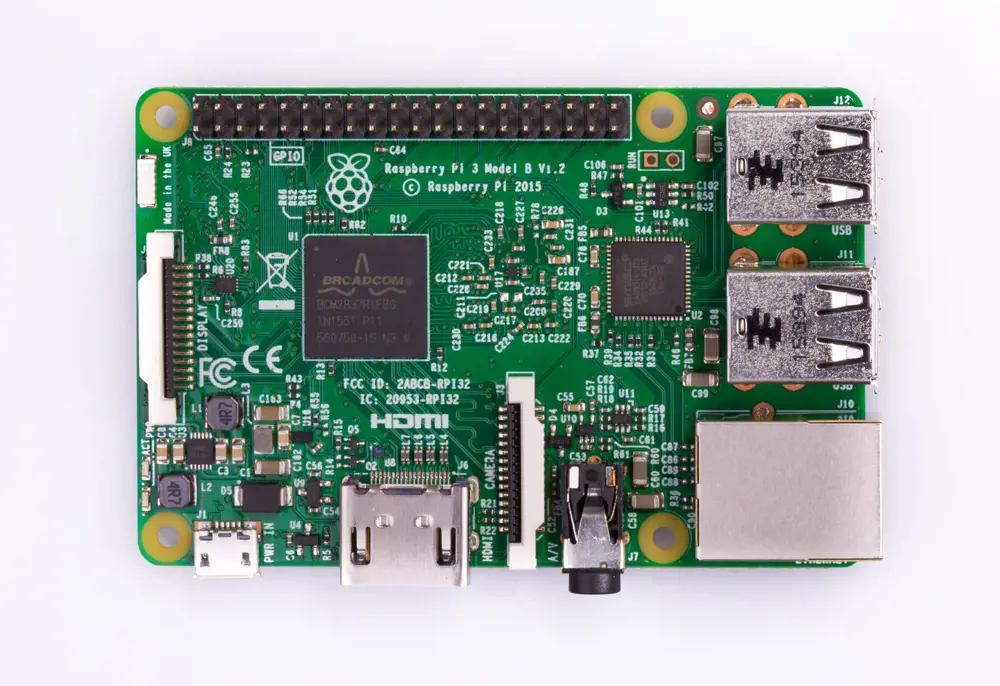
The Raspberry Pi 3, the foundation’s flagship product, is a bare circuit board that can connect to many different devices © Raspberry Pi Foundation
The ARM processor allowed the new micro-computer to run its own variant of the Linux open-source operating system, Raspbian. This meant that the Raspberry Pi, known as the Pi in the community, started life with a full-function operating system that came with many programming languages and device drivers. The Pi team did not have to write a library of software before it brought the device to market: it could tap into the creativity and software of the large Linux community and many existing applications.
With the basic design ready, the team set itself challenging cost targets: it wanted to sell a fully capable personal computer for around £20 ($35). At the time, single-board computers cost around $100. The team also wanted its computer to connect to a wide range of devices and add-ons.
This connectivity also came into play with another important design feature: the Pi is a bare circuit board rather than a closed box that things are plugged into. Students are able build their own digital devices, which they can connect to anything that takes their fancy and that uses standard interface protocols for displays, network devices and anything that can work with the USB drivers written for Linux, such as printers. This design philosophy encourages the Pi’s use as a programmable controller/interface, promoting a large and growing ‘digital making’ community of students, hobbyists and individuals who have created all manner of devices based on a variety of hardware, from robots and heart monitors to irrigation systems, catflaps and many examples of devices on the internet of things.
“Almost every branch of engineering embeds computers one way or another,” he says. “The Pi gets young engineers started on that journey. To me the attraction of digital making is that it turns ‘electronics’ into ‘software’
The Pi’s flexibility has enormous implications. For example, Dr Andrew Herbert OBE FREng, a member of the MacRobert judging panel and previously Chairman of Microsoft Research for the Europe, Middle East and Africa region, sees digital making as a pathway into careers in engineering. “Almost every branch of engineering embeds computers one way or another,” he says. “The Pi gets young engineers started on that journey. To me the attraction of digital making is that it turns ‘electronics’ into ‘software’. Surround the Pi with a few simple interfacing chips, sensors and actuators, and write software to do all the control and data transfer – there is no need to learn how to design complicated electronics.”
The designs for the Pi might have gone nowhere had it not been for what Dr Upton describes as an “accidental announcement”, when the BBC’s technology correspondent, Rory Cellan-Jones, mentioned the new computer in a blog in May 2011. “We got this enormous deluge of attention, and then we had to make it.”
We got this enormous deluge of attention, and then we had to make it
While Lomas worked on the important task of bringing all the components together onto a device about the size of a credit card, Dr Upton took to the telephone to persuade chip makers to sell at a price that would meet the Pi’s £20 target. Hoping to order just 10,000 or so chips, he had limited bargaining power. He had no idea that the companies he talked to would end up selling chips by the million.
There was also a “frantic scramble”, Dr Upton recalls, trying to find someone to make the devices. After failing to find a British maker, Raspberry Pi scraped together $250,000, mostly the trustees’ own money, to pay a Chinese manufacturer to assemble the first 10,000 units.
In February 2012, the team invited people to sign up to buy the Raspberry Pi Model B. As Dr Braben recalls it, although there was no delivery date, when sales started, the rush to buy was so frenzied that it crashed the website and sold out “within seconds”. Following this success, Raspberry Pi could rethink its production strategy and approached a Sony factory in Wales that did contract production for other businesses, bringing production of the Pi back to the UK.
Launched officially at the end of February 2012, sales of the Pi 1 Model B hit 100,000 on the first day. By the end of the year, sales reached 800,000. The team decided to set up Raspberry Pi Trading, with Dr Upton as CEO, to develop the third model, the B+. The new design gave developers even more access to the internals, further opening up the machine to new applications. Importantly, the team ensured that anything developed for the earlier machines would work on later models without any changes.
It was not long before the Pi team’s achievements began to be recognised. In 2013, Dr Upton’s achievements in bringing the Pi to the market won him a Royal Academy of Engineering Silver Medal for outstanding commercial success.
Away from the classroom
🥒 Building business on the back of Raspberry Pi and many ingenious uses
The creators of the Raspberry Pi may not have set out to support manufacturing, research and other areas where an inexpensive, easily programmable, multi-purpose computer is invaluable, but that has certainly been a key part of Pi’s success. “We like that people are building businesses on the back of the Raspberry Pi,” says Dr Upton.
Along with schools and hobbyists, engineers in industry quickly started to experiment with the Pi. This sector now accounts for about a third of all sales, with applications in just about every area of engineering and research.
The Pi found favour in industry thanks to “ferocious attention to detail and in developing affordable production techniques to create a system that can be built cheaply yet to a very high quality,” says Dr Herbert. This makes the Pi acceptable for use in practical engineering solutions in an industrial environment. One of Dr Upton’s favourite applications is at a cucumber farm in Japan, which, thanks to the farmer’s programmer son, uses a Pi to sort thorny cucumbers, saving the farmer eight to nine hours’ manual work a day.
Researchers have also latched on to the Pi as a way of reducing the cost of equipment. A group of neuroscientists at the University of Tübingen, Germany, and University of Sussex has used 3D printed components and self-programmed electronics in a $100 imaging and microscope system that replaces commercial instruments that could cost tens or even hundreds of thousands of euros. Dubbed FlyPi, the system helps the researchers in their studies of roundworms, fruit flies, zebrafish larvae and other small animals.
Lots of Pis: other ingenious uses of Pi
- The BrewPi Spark 3 can control the temperature of beer or wine fermentation with 0.1°C precision. It sends data to a Raspberry Pi to show a control panel with graphs in a browser.
- OpenSprinkler Pi, an open-source sprinkler/ irrigation extension board for Raspberry Pi, for garden and lawn watering, plant and flower irrigation, hydroponics, and other watering projects.
- Twike two-seat electric pedal cars, made in Germany, use a Raspberry Pi to collect and display information for the driver.
- An Indian team designed a Pi-based system to alert doctors when something abnormal happens on medical instruments that monitor electrocardiograms and other vital parameters.
Coding in the community
As the MacRobert citation says, the Raspberry Pi hardware has done much to put computing back into the hands of hobbyists, who were the early adopters of the Raspberry Pi, schools, and engineers in industry who want to develop inexpensive devices based on open standards. Pis make it easier for schools to teach students how to write code and introduce the skills that are invaluable in an increasingly digital society and, as the Pi started to come off the production line, it was the role of the Raspberry Pi Foundation educational charity to get that message out to schools.
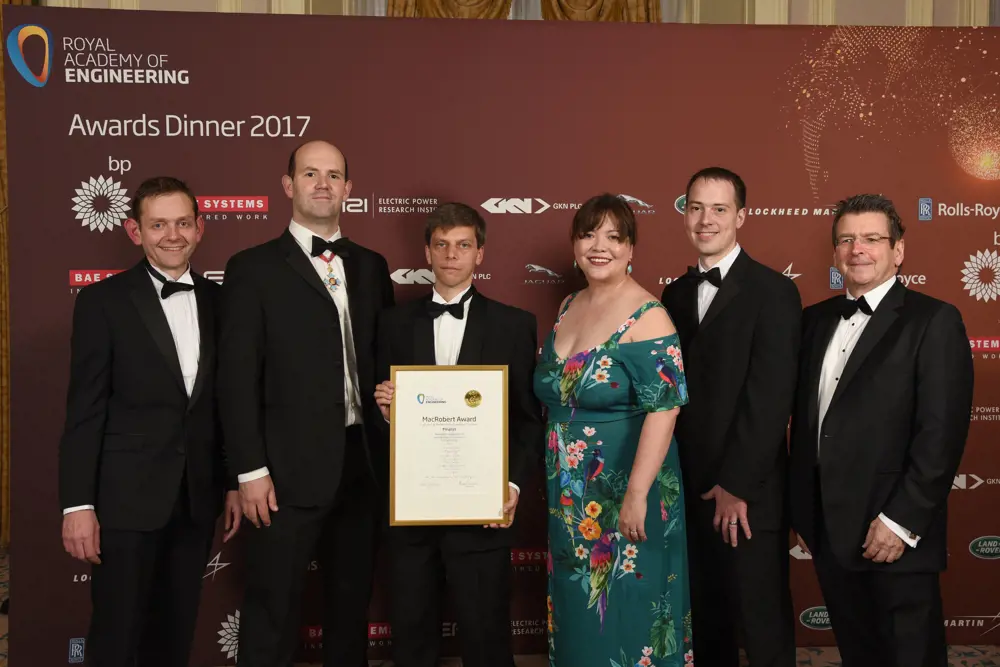
The MacRobert Award 2017 was presented to the Raspberry Pi team at the Royal Academy of Engineering’s annual Awards Dinner in June (L–R): Dr Gordon Hollingworth, Director of Software Engineering; Dr Eben Upton CBE, CEO; Dom Cobley, Senior Principal Engineer; Liz Upton, Director of Communications; James Adams, COO; and Pete Lomas, Co-founder and trustee
Raspberry Pi Trading reinvests about a third of its profit in R&D, and the rest goes to the foundation. Grants and donations from other sources make up around half of the foundation’s income. The turnover of Raspberry Pi Trading was around £16 million in 2016, yielding a profit of £8.9 million, which supports a wide range of community, outreach and learning activities. Several schemes support the original aim of bringing the excitement of programming to the classroom, such as Code Club, a network of teacher- and volunteer-run after-school programming clubs. There are now more than 10,000 Code Clubs running in 125 countries. “More than 140,000 kids have taken part in our clubs in places as diverse as the northernmost tip of Canada and the favelas of Rio de Janeiro,” says Katherine Leadbetter, Code Club International Programme Coordinator. The activities of Code Club go beyond the original aim of reviving classroom interest in writing code. One club in Zambia, run by volunteer Mwiza Simbeye, started as a way of getting children off the streets of Lusaka and teaching them useful skills.
The foundation also helps computing teachers in their classroom activities. For example, Picademy runs free two-day residential training courses in computing and digital making for educators. There are also free online training courses for teachers and one-day workshops for teachers who want to start a Code Club.
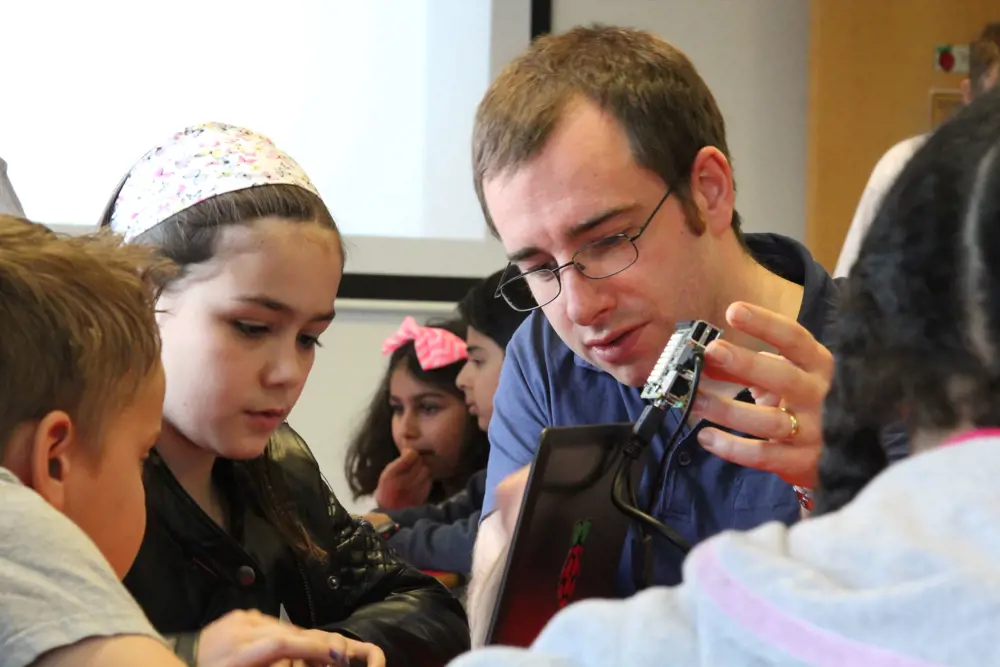
A teacher helps a child program a Raspberry Pi at one of the foundation’s many Code Clubs. As part of its mission to put the power of digital making into thehands of people everywhere, Raspberry Pi provides free, high-quality learning resources and both face-to-face and online training for educators © Raspberry PI Foundation
The foundation’s activities also support broader uses of the Pi. For example, around 250 teams from 15 countries are taking part in the current round of AstroPi competitions, which give young people the opportunity to design experiments and write programs that run on the International Space Station. Another project that uses Pi for scientific education is the Skycademy, in which trained educators work in teams with a high-altitude balloon pioneer to take photographs, and record and transmit atmospheric data back to the ground. In a joint programme with Oracle, 800 schools in 72 countries run Pi-based weather stations.
As Dr Herbert puts it, “through these outreach and educational activities, the foundation addresses the very need that first stimulated the invention of the Raspberry Pi, namely the desire to inspire young people to take an interest in computing and digital making, essential skills for the UK if it is to remain competitive in an increasingly digital world. It brings into schools the discipline and thrill of engineering problem solving and creative thinking.”
The maker movement has also encouraged rapid growth in another market far beyond the founders’ original ambitions. A third of the sales of the Pi are outside education, in industrial automation and consumer electronic devices. The Pi also finds its way into embedded controllers, data loggers and development platforms.
By the end of 2016, global sales of Pi computers exceeded 11 million, 80% of which were exported, making it the UK’s best-selling computer. After just five years, the Raspberry Pi is a major player, not just in education and the personal computer market, but in a growing number of applications in countless areas of engineering.
***
This article has been adapted from "Chips that changed the classroom", which originally appeared in the print edition of Ingenia 72 (September 2017)
Contributors
Michael Kenward OBE
Author
Dr Eben Upton CBE is Co-founder and CEO of Raspberry Pi Trading. He was responsible for the overall software and hardware architecture of the Raspberry Pi, and is a former trustee of the Raspberry Pi Foundation.
Dr Andrew Herbert OBE FREng is a member of the MacRobert Award judging panel. He was formerly Chairman of Microsoft Research EMEA and is Chair of Trustees for The National Museum of Computing.
Keep up-to-date with Ingenia for free
SubscribeRelated content
Software & computer science
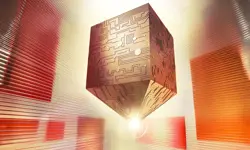
Pushing the barriers to model complex processes
In 2007, Imperial College London spinout Process Systems Enterprise Ltd won the MacRobert Award for its gPROMS (general-purpose PROcess Modelling System) software. Costas Pantelides and Mark Matzopoulos, two of the key people behind the success of gPROMS, tell how they created a way in which engineers can harness physics, chemistry and engineering knowledge within a framework that solves highly complex mathematical problems.
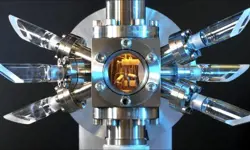
Compact atomic clocks
Over the last five decades, the passage of time has been defined by room-sized atomic clocks that are now stable to one second in 100 million years. Experts from the Time and Frequency Group and the past president of the Institute of Physics describe a new generation of miniature atomic clocks that promise the next revolution in timekeeping.
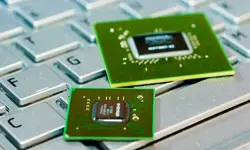
The rise and rise of GPUs
The technology used to bring 3D video games to the personal computer and to the mobile phone is to take on more computing duties. How have UK companies such as ARM and ImaginationTechnologies contributed to the movement?
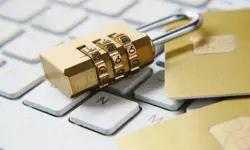
EU clarifies the European parameters of data protection
The European Union’s General Data Protection Regulation, due for adoption this year, is intended to harmonise data protection laws across the EU. What are the engineering implications and legal ramifications of the new regulatory regime?
Other content from Ingenia
Quick read

- Environment & sustainability
- Opinion
A young engineer’s perspective on the good, the bad and the ugly of COP27

- Environment & sustainability
- Issue 95
How do we pay for net zero technologies?
Quick read

- Transport
- Mechanical
- How I got here
Electrifying trains and STEMAZING outreach

- Civil & structural
- Environment & sustainability
- Issue 95